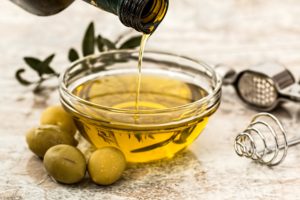One of the great nutrition debates that has been following us through the years is all about fats. Do I eat more fat or less fat? Is saturated fat good or bad? Do I need to eat less cholesterol? Should I be fat-free? Is fat in my diet going to add fat to my body?

SO MANY QUESTIONS!!!
Fat actually has a lot of necessary roles for us to be able to function well and be healthy. Fats provide us with insulation & protection for our organs, they are major parts of our cell structure, have roles in nerve transmission, regulate our hormone production, and allow us to absorb certain vitamins.
When you hear people talking about fat in the body, referring to extra body weight, it doesn’t necessarily mean it’s because they ate too much fat in their diet! Fat in the body is a way for us to store extra energy. When we eat, we get our energy from carbohydrates, fats, and proteins. Whenever we eat more than what our body needs, the extra is stored as fat… and that can be extra from any of the nutrients that give us our energy: fats, carbs, or protein!
So that’s a good thing, right? We need fat… there’s fat in food… case closed?
Not quite…
Not all fats are created equal! We have saturated fat & cholesterol, trans fat, monounsaturated fat, & polyunsaturated fat.
Of these fats, the evil-doer of the year award (or 60 years really… this stuff has been around since the 1950’s) is going to go to trans fat. People found a way to take liquid fats like oil and add ingredients to change the chemical structure of the oil and make it more solid. It’s cheap, tasty, and gives the food a longer shelf life. Unfortunately, trans fat also raises your blood cholesterol levels, increases your chances for heart disease, increases your chances of having a stroke, and also increases your chances for developing type 2 diabetes!
The good news is that the use of trans fat has been cut WAY down! Some places have even banned the use of them since the discovery of their effect on our health. We also have labeling requirements through the FDA so food manufacturers have to include trans fats on the nutrition label. The only downside there, is that the label only has to include trans fats if there are more 0.5grams per serving. The only way to know for sure, is by checking the ingredients! Here’s an example:
 There’s 0g of trans fat listed here. But if you look toward the bottom at the ingredient list, it includes “hydrogenated vegetable oil.” This product has less than 0.5g trans fat, but eating multiple items containing just a little trans fat every day… adds up. Look for “hydrogenated oils” or “partially hydrogenated oils” when checking for trans fat.
There’s 0g of trans fat listed here. But if you look toward the bottom at the ingredient list, it includes “hydrogenated vegetable oil.” This product has less than 0.5g trans fat, but eating multiple items containing just a little trans fat every day… adds up. Look for “hydrogenated oils” or “partially hydrogenated oils” when checking for trans fat.
If you were going to find these types of fats in food, the foods you want to look at would be fried foods, baked goods, frozen or processed meals, & stick margarine. The photo example I uploaded was from a jar of peanut butter! Not all peanut butter has this… but this particular one happened to be more processed; as you can see, there’s more ingredients in this food than just “peanuts.” The FDA even said trans fat is no longer “generally recognized as safe.” & “a probable significant health risk.” So, when we see “trans fat” on the nutrition label, or “hydrogenated/partially hydrogenated oil”, that’s our flag to steer clear!
I think the effects of trans fats are [mostly] clear. I say that with a light heart as anyone even remotely interested in nutrition knows there’s very little that’s just black and white!
It’s the land of gray… All us crazy nutrition folk live in a giant gray house in the middle of Grayville surrounded by a vast gray universe! 🙂
And our gray topic of today is….(insert drumroll…)
SATURATED FATS AND CHOLESTEROL!!
Saturated fats are fats that are solid at room temperature. You can find them  in foods like meat (and definitely meat w/ skin), butter, higher fat dairy products, and tropical oils (such as coconut or palm oil.) Cholesterol is a type of fat that is found in animal products. You can find cholesterol in meats, butter, higher fat dairy products, & eggs.
in foods like meat (and definitely meat w/ skin), butter, higher fat dairy products, and tropical oils (such as coconut or palm oil.) Cholesterol is a type of fat that is found in animal products. You can find cholesterol in meats, butter, higher fat dairy products, & eggs.
I’m not going to dissect the different studies on these topics. There have been quite a few over the years and I think it would be more beneficial to get right to discussing current recommendations.
The newest guidelines have actually removed the cholesterol limitation for dietary intake. That doesn’t mean cholesterol isn’t important anymore! High cholesterol in your blood is definitely still an issue, however, cholesterol that we eat in our food isn’t the biggest factor in raising the cholesterol in our blood. Research has been supporting the idea that saturated fat and trans fat effects our cholesterol more than dietary cholesterol does.
Well we already know what we do with trans fat, so what about saturated fat now? Some research says it increases risk of heart disease, and some research says it doesn’t! So…. ??
You want to limit your saturated fat intake to less than 10% of your total calories every day. But wait! There’s a little more work to be done….
Even though there’s mixed results on saturated fat and heart health, there IS support that if you replace saturated fats with unsaturated fats, you are decreasing your risk for heart disease. The total amount of overall fat you should eat every day is 20-35% of total calories.
 This is where the rest of our fats come in… mono and polyunsaturated fats. These are the types of fats that are liquid at room temperature. You can find them in foods like nuts, seeds, fatty fish like salmon & trout, oils such as olive or canola, and avocado.
This is where the rest of our fats come in… mono and polyunsaturated fats. These are the types of fats that are liquid at room temperature. You can find them in foods like nuts, seeds, fatty fish like salmon & trout, oils such as olive or canola, and avocado.

When you hear the term “good fats” or “heart healthy fats”, it’s referring to mono and polyunsaturated fats. These are the types of fats that have been linked to regulating inflammation, reducing blood pressure, and lowering cholesterol.
I threw a lot of information in here about what the different types of fats are, where you can find them, what they do, and how much you should eat. It might seem like too much to remember, but here are some tips you can follow for a healthy eating pattern that helps puts all of that information together when you’re grocery shopping:
- Read nutrition labels and avoid foods with trans fat
- Substitute liquid fats (like olive or safflower oil) in recipes that call for butter, margarine, or shortening
- Limit baked products, fried foods, and frozen/processed meals
- Choose lean cuts of meat without skin and eat a variety of other protein foods such as legumes, nuts, & fish
- Choose lower fat dairy products

Never thought to check ingredients when a product has 0g of trans fat on the label. SNEAKY!!!
Nice article a lot of info I didn’t know about. Thank you
I learned something new (again!), After I look for “trans fat” on the label, I never thought to look further for “hydrogenated”!!!
Honestly, the example I used surprised me! I went through the kitchen to find an easy-to-read nutrition label to point out the areas to look in. And much to my surprise… I found hydrogenated vegetable oil in the peanut butter! :/ While it ended up being the perfect example for that part of my article, I was still pretty disappointed to find it.